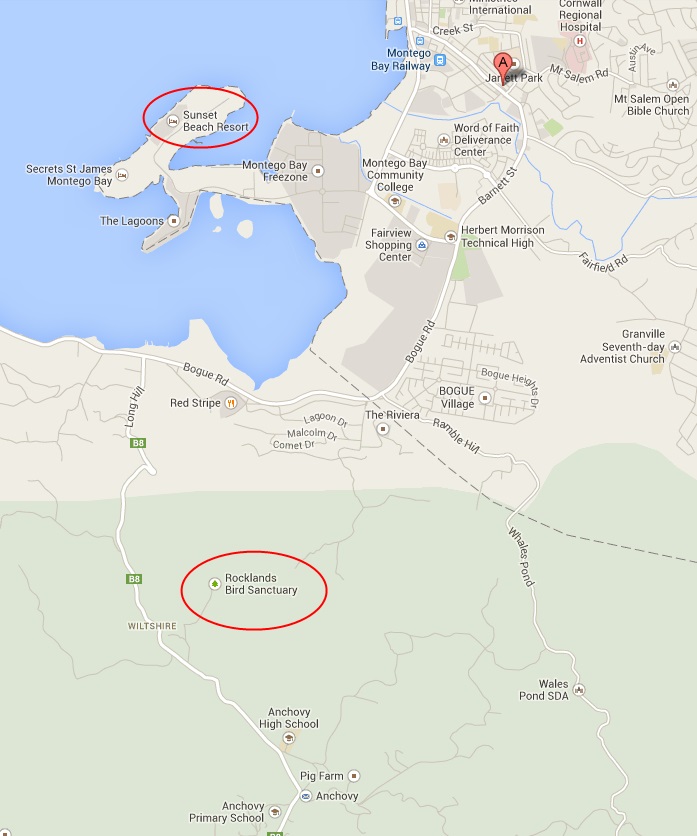
Jamaica birding
Rocklands Bird Sanctuary - doc (1st bird is Yellow-Faced Grassquit: http://things-to-do-in-jamaica.com/rocklands-bird-sanctuary-jamaica/ )
+1 876-952-2009
rocklandsbirdsanctuary@gmail.com
https://www.facebook.com/pages/Rocklands-Bird-Sanctuary/102659889789115
Rocklands was established by Lisa Salmon, one of Jamaica's first environmentalists. Miss Salmon or "the bird lady" as she was affectionately known purchased the Rocklands property in 1954. She spent her time writing, painting and feeding birds. It didn't take long for the house to attract a wide variety of birds and by 1962 Miss Salmon opened Rocklands to the public. Lisa sadly died in 2000 at the age of 96 but her legacy lives on. Rocklands is now run by Lisa's nephew and managed by Fritz. Fritz has been working at Rocklands for over 15 years and has a gift for spotting and beckoning the birds which dwell in the surrounding trees.
The Rockland's Bird Feeding Sanctuary at Anchovy is approximately 30 minutes away from Montego Bay by car. Take the main road West of Montego Bay (towards Lucea and Negril), after about 3 miles you will come to a town called Reading where a clearly marked sign points to the road leading inland (left). Follow this inland road for about half a mile until you see signs to the bird sanctuary. The road is in need of repair but is traversable by a regular car.
http://www.jamaicatravelandculture.com/destinations/st_james/anchovy.htm
US$20 per person includes coffee, tea or juice.
"We left our hotel at 10:00 for our trip & enjoyed the scenery along the way.
Our driver had to turn off the a/c for a bit in his old van to make it up the
hill. When we got to the place another couple was there & just going on the
garden tour. Even before our guide came, birds were flitting by us. It was
amazing to see the lovely
Doctor Bird
(紅嘴長尾蜂鳥) so close.
We sat down, got our bottles than the guide started calling the birds. It wasn't
long until one came plus there was a variety of birds on the feeders. The guide
took pictures with my camera which was fine for this part of the experience but
I would have liked to take my own pictures on the walk. On the other hand on our
walk he went out of his way to find & photograph a Jamaican Tody for me. The
scenery was lovely & he explained some trees, termite nests & flowers. "
src
Take taxi or join a tour.
http://www.getyourguide.com/montego-bay-l238/montego-bay-tour-rockland-s-bird-sanctuary-t33304/#reviews - from US$ 39.00 (per person) - Duration: 2 hours, Private tour

1. 032png; others: 27-30, 33, etc.

 Birds of the West Indies p.195
Birds of the Dominican Republic and Haiti p.202 (much
larger than grassquits)
Birds of the West Indies p.195
Birds of the Dominican Republic and Haiti p.202 (much
larger than grassquits)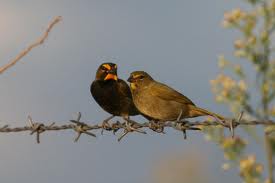
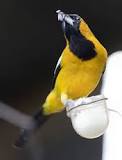
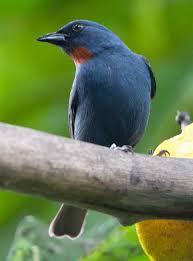
| Orangequit, Stripe Headed Tanger, Saffron Finch, Bananaquit, Greater Antillean Bullfinch, Black-Faced Grassquit, Yellow-Faced Grassquit c. 1940 src |
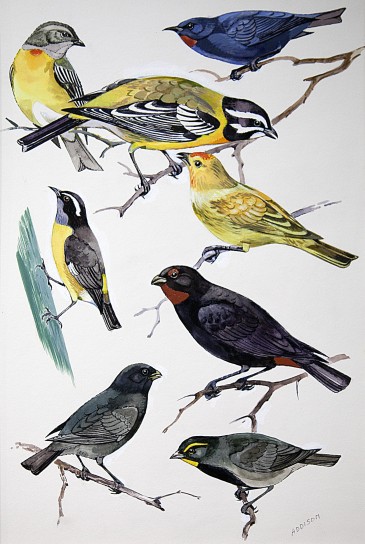 |
http://helensbirds.homestead.com/cruise04jamaica.html
The Rockland's Bird Sanctuary was originally owned and run by "the bird lady" Lisa Salmon, who sadly, had passed away in 2000, in her 90's. Fortunately the property is still being run as a sanctuary, by Ms Salmon's nephew, and it is managed by Fritz, who told us that he'd been there for 15 years, staying on after Ms. Salmon died. There was an US$8 entrance fee and a separate fee for a guided tour which appeared to be "negotiable" - discuss this with the guide before you start the tour! Hours of operation had been posted in the tourist office, as 2-5 pm, when the birds would be fed, but we arrived at 11.30 am, and were invited straight on to a covered patio which was buzzing with hummingbirds. The Red-billed Streamertail*(E) and Jamaican Mango*(E) were so tame that they would come straight to a handheld bottle of sugar water and some of them would even sit on your finger to feed, if you were lucky! There are 4 species of hummingbird resident in Jamaica - 3 of them can be found at Rocklands, but the 4th, the Black-billed Streamertail, is only found in the very eastern part of Jamaica (it is sometimes treated as a sub-species of the Streamertail). The next treat was to hand feed the Black-faced Grassquits*, Yellow-faced Grassquits* and Orangequits*(E) by holding out a hand full of millet seed. I was in seventh heaven ....! Also hopping around the feeders on the patio, were Banaquits*, a Greater Antillean Bullfinch* and a Black-throated Blue Warbler* male.
Fritz then led us out into the wooded area beyond the covered patio and we soon saw a Jamaican Woodpecker*(E) and White-chinned Thrush*(E). Further along the trail we actually found a couple of familiar species - a Northern Parula and a colourful male American Redstart, and later we also saw a female redstart. Fritz proved to be an excellent guide and spotted many birds we would never have seen without his help. Our next 4 species were all endemic to Jamaica, as well: the Rufous-tailed Flycatcher*(E), looking very similar to our North American Great-crested Flycatcher and we were lucky to watch it catch a large cricket; the Jamaican Tody*(E) which looks like a hummingbird on steroids; the Jamaican Euphonia*(E) and the Jamaican Vireo*(E). We also spotted the tiny (2.5 in) Vervain Hummingbird*, found only in Jamaica and Hispaniola. Finally, Fritz pointed out a Loggerhead Kingbird*, very similar to our Eastern Kingbird, and then it was time to go back as we didn't want to be late for our taxi rendez-vous.
On our way back, Fritz led us off the trail a short way to see if he could locate a Potoo which he had found roosting on a certain tree stump several days before, but unfortunately it was not there for us. However we did find a Common Ground-dove and 3 Caribbean Doves*. Back at the sanctuary gardens we watched the feeders for a while and got another lifer when a couple of Jamaican Orioles* visited the nectar feeders. This oriole is a common resident found only in Jamaica and San Andres. In the trees beyond there were some black birds which we finally identified as Shiny Cowbirds*. The other possibility had been the endemic and endangered Jamaican Blackbird, which is now uncommon and usually only found at higher elevations.
We left Rocklands to walk the short way along the road to the appointed rendez-vous with our taxi and en route saw a Turkey Vulture soaring above and then were fortunate enough to have an American Kestrel land on some power lines quite close to us. This female kestrel seemed to be quite curious and let us get a couple of photos. In the same area we also saw a couple of parrots, one of which was too far away to see well, but we identified the second one as the threatened Black-billed Parrot*(E). We felt very lucky to have found one on our really short visit to Jamaica!
Back on the ship in the late afternoon, we watched a kettle of Magnificent Frigatebirds as they came in to roost on some islands in the bay to the south of the cruise ship pier. There were several juveniles with white heads, having a difficult time landing on the roost trees! Cattle Egrets, Double-crested Cormorants and a Great Egret, were also using the same roost.
34 species, 20 lifers*
(11 of them endemics ~ E)
Species list:
Magnificent Frigatebird
Double-crested Cormorant
Brown Pelican
Great Egret
Cattle Egret
Black Vulture
Turkey Vulture
American Kestrel
Royal Tern
Common Ground-Dove
Caribbean Dove*
Black-billed Parrot*E
Jamaican Mango*E
Red-billed Streamertail*E
Vervain Hummingbird*
Belted Kingfisher
Jamaican Tody*E
Jamaican Woodpecker*E
Rufous-tailed Flycatcher*E
Loggerhead Kingbird*
Jamaican Vireo*E
White-chinned Thrush*E
Northern Mockingbird
Northern Parula
Black-throated Blue Warbler*
American Redstart
Bananaquit*
Jamaican Euphonia*E
Yellow-faced Grassquit*
Black-faced Grassquit*
Greater Antillean Bullfinch*
Orangequit*E
Jamaican Oriole*E
Shiny Cowbird*
© 2004 Helen Baines
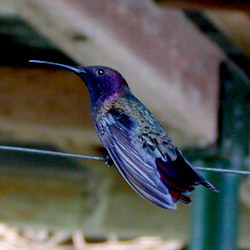
Beautiful colors of the Jamaican Mango